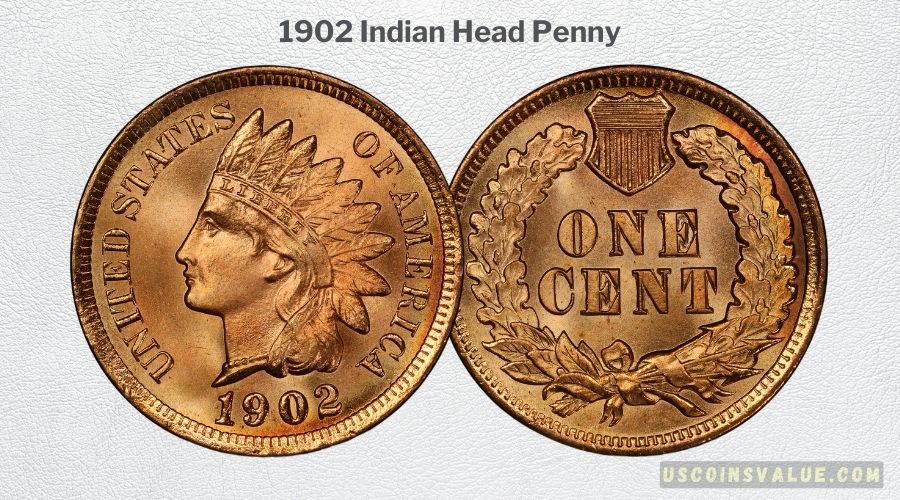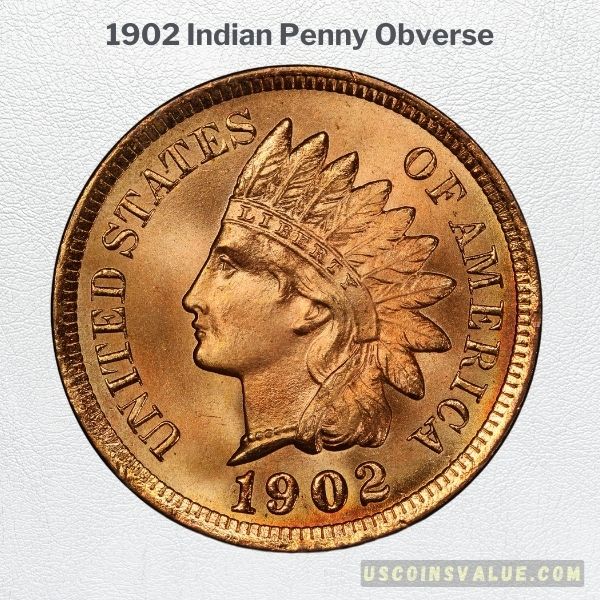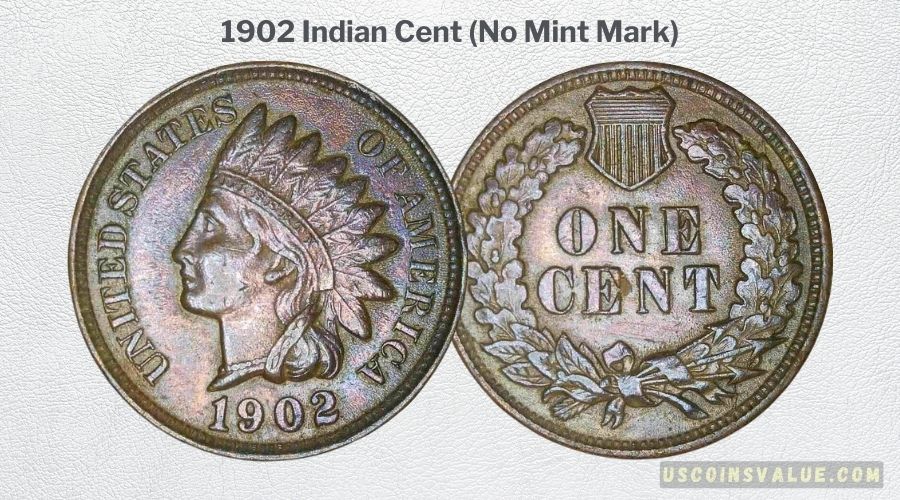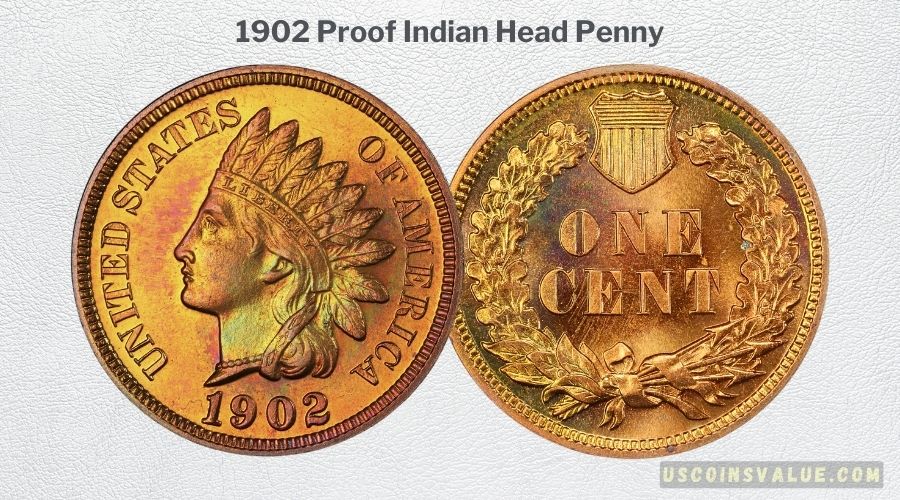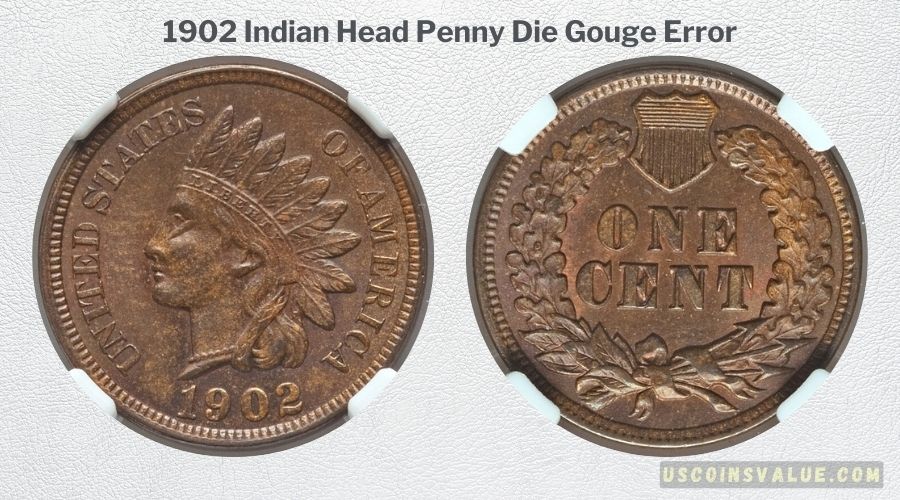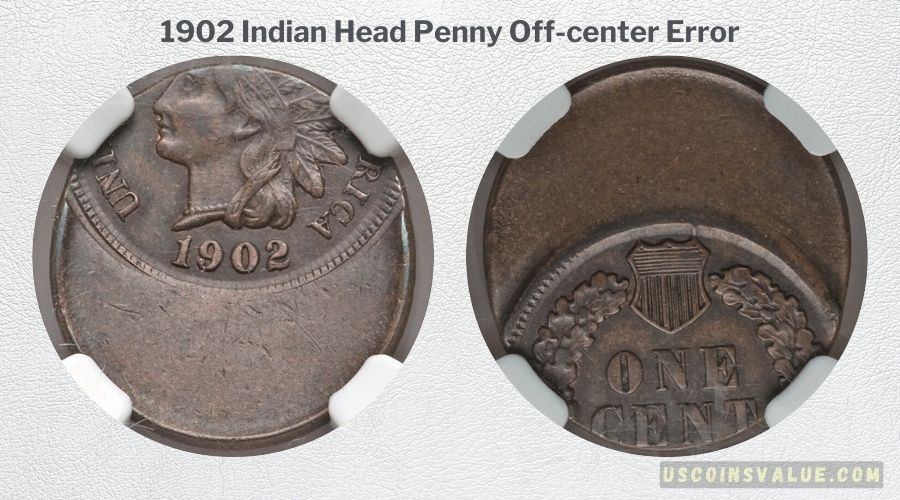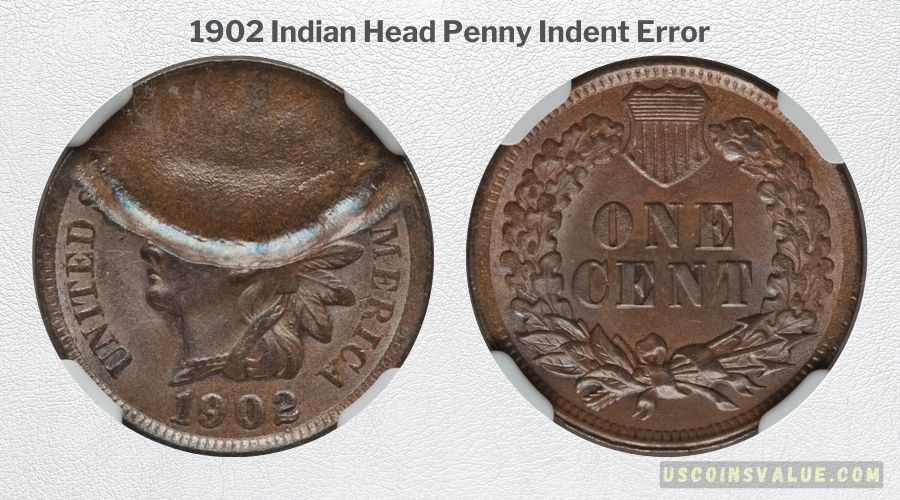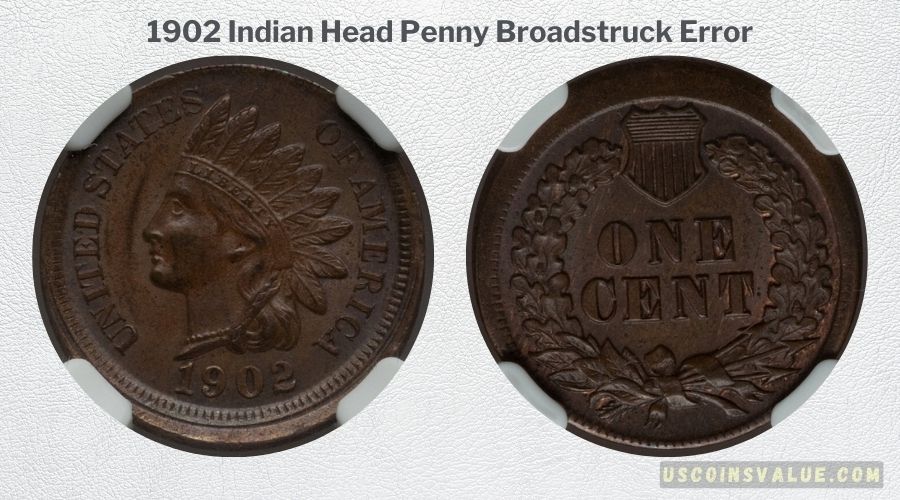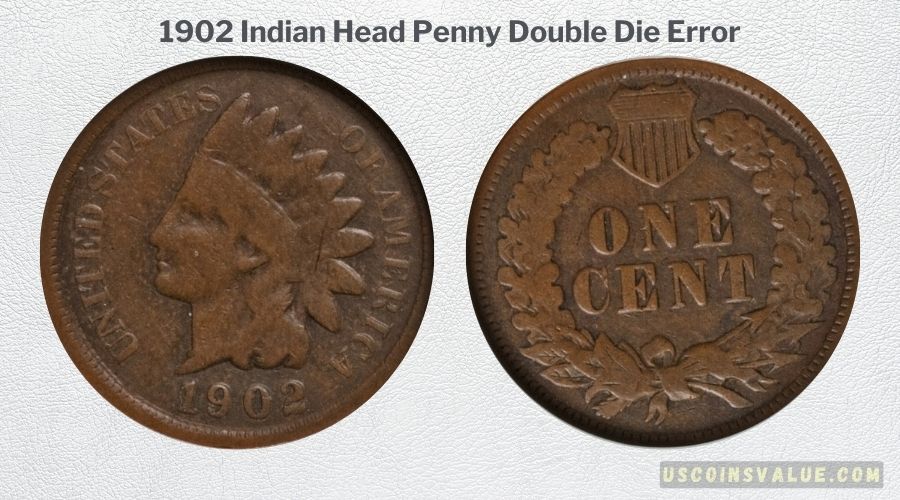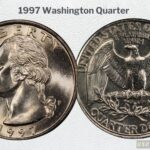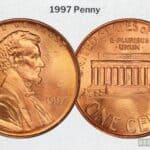Have you recently come across a 1902 Indian Head Penny? If you have, you must wonder if it will make a worthy addition to your collection or if it’s just another little piece of history.
If you’re lucky enough to find one in an uncirculated Mint State, numismatists can be willing to pay between $46 and $75 for regular strike coins and $292 for proof coins.
On one occasion, a 1902 Indian Head Penny was sold for a record auction price of $144,000, so you might be sitting on a huge gold mine if you have one.
As one of the longest-running coins in American numismatics, the 1902 Indian Head Penny is packed with history. So, if you want to learn more about this coin, keep reading as we’ll discuss the 1902 Indian Head Penny value, its history, design, and everything else there is to know.
What is the History of the 1902 Indian Head Penny?
In numismatics, the older a coin is, the harder it is to find and the more valuable it is. At over 100 years old, the 1902 Indian Head Penny is revered and often valued higher than some other coins despite its low face value of only one cent.
This century-old coin gets rarer with each passing year. However, finding one isn’t impossible. It is also rich in history, as the inception of its design goes as far back as 1859.
In 1859, the Chief Engraver of the U.S. Mint, James B. Longacre, released a new design to replace the portrait of the flying eagle on one-cent coins. This new design depicted a female figure wearing an Indian headdress, which inspired the name of the category of coins known as the “Indian Head Cents.”
However intriguing as this may sound, there is some controversy surrounding the image on the coin. Some numismatists believe it is the image of Lady Liberty of the famous Statue of Liberty.
On the other hand, some believe it is a portrait of James B. Longacre’s daughter, Sarah Longacre who is simply wearing a feathered headdress. As such, the name “Indian Cents” is sometimes called a misnomer.
Whatever the case, Indian Cents or Indian Head Pennies were minted for over 50 years, making them some of the longest-running coin series in American numismatics.
Now, let’s examine the specifications of this coin.
1902 Indian Head Penny Features
1902 Indian Head Penny Specifications
- Category: Indian Head Cents or Indian Head Pennies (1959 – 1909)
- Year of Make: 1902
- Mint Branch: Philadelphia (No mint mark)
- Total Mintage: 87,374,704
- Face Value: $0.01
- Composition: 95% Copper, 5% Tin & Zinc
- Weight: 3.11 grams
- Diameter: 19 millimeters
- Edge: Plain
Obverse & Reverse: What does the 1902 Indian Penny look like?
As already mentioned, the obverse and reverse of the 1902 Indian Head Penny were designed by James B. Longacre, along with other Indian Head Pennies.
The obverse of the 1902 Indian Penny features a female figure wearing what resembles an Indian headdress in the left profile. Besides the headdress, the female figure is also adorned with pearls on her neck.
This side of the coin has the following inscriptions;
- UNITED STATES: On the left side of the coin, in front of the female figure.
- OF AMERICA: On the right side of the coin, behind the Indian headdress.
- LIBERTY: Across the band of the headdress.
- 1902: At the bottom of the coin, just below the neck of the female figure.
The reverse of the 1902 Indian Cent shows a small shield at the top-center of the coin, with a wreath on either side. At the bottom of the coin, you can find a set of about three arrows intertwined through the wreath underneath the ribbons.
The only inscription you can find on this side of the coin is as follows;
- ONE CENT: Sits in the center of the coin, surrounded by the wreath, shield and the bunch of arrows.
1902 Indian Head Penny Varieties
A coin can be presented in two, three, or more varieties, depending on its mint location and composition.
A coin minted at the Denver Mint facility would feature the mint mark “D,” while one from the San Francisco Mint would show the mint mark “S.” The “P” mint mark is unique to coins minted at the Philadelphia Mint.
However, the 1902 Indian Head Penny was only minted at the Philadelphia Mint as it was the only mint facility authorized to operate at the time.
This coin features no mint mark but was minted in regular strike and proof varieties, with the mintage as follows;
| 1902 (Indian Head Penny Varieties) | Composition | Mint Location | Mintage |
| 1902 (Regular Strike) | 95% Copper and 5% Tin & Zinc | Philadelphia | 87,374,704 |
| 1902 (Proof Strike) | 95% Copper and 5% Tin & Zinc | Philadelphia | 2,018 |
What is the 1902 Indian Head Penny Value Today?
With only over 87 million coins minted, the 1902 Indian Head Penny may not be as easy to find as other coins. Hence, it can be worth much more than its face value, depending on the condition you find it in.
Currently, the 1902 Indian Head Penny is worth a minimal face value of $0.01 and a melt value of $0.0244.
Like other copper or bronze composite coins, the 1902 Indian Head Penny changes in feel, color, and general appearance due to wear.
A 1902 Indian Head Penny in good condition, Mint State, or Proof would still retain its shiny red luster, while a well-worn penny would lose its red luster and appear brown.
To differentiate among the different grades and colors of this coin, professional numismatists use the following grading scale in conjunction with the regular numeric grading scale;
- RED (RD): Coins with RD strike character are copper coins graded at least MS60. They exhibit 85% to 95% of their original red color.
- RED-BROWN (RB): These coins graded at least MS60 show at least 15% of their original red luster.
- BROWN (BD): Coins that appear dull and only show less than 5% of their original red mint luster.
Going by the most recent NGC Price Guide, if you find a 1902 Indian Head Penny in MSBD (Mint State Brown) condition, it can sell between $1.50 and $35 or more.
If you’re lucky enough to find one in MSRD (Mint State Red) condition, coin collectors can be willing to pay as much as $17,000.
The comprehensive summary chart below shows how this coin is valued today.
| Grade (MSRD) | 1902 Indian Head Penny (Regular Strike) | 1902 Indian Head Penny (Proof Strike) |
| 59 | N/A | N/A |
| 60 | N/A | N/A |
| 61 | $75 | N/A |
| 62 | $85 – $95 | N/A |
| 63 | $130 – $175 | $325 |
| 64 | $215 – $270 | $650 |
| 65 | $600 – $1,000 | $950 |
| 66 | $1,750 – $3,000 | $1,600 |
| 67 | $10,000 | $7,500 |
| 68 | $17,000 | $32,500 |
1902 Indian Cent (No Mint Mark) Value
As one of the later Indian Cents minted in the early 1900s, the U.S. Mint did not produce the 1902 Cent in billions like other coins. This somewhat low mintage makes it worth keeping, so if you find one of these coins, you definitely want to hold on to it.
A 1902 Indian Head Penny of grade MSBN66 can sell for as high as $290, while an MSRB66 can sell for up to $900. Rarer and pristine grades of MSRD68 go for as high as $17,000.
It is important to note that this coin was minted over a century ago, therefore it might be difficult (but possible) to find one in pristine condition.
One of the most recent prices paid for a 1902 Indian Head Penny graded MS67RD was $19,200 in February 2023, while a grade MS66RD sold for $2,100 in May 2023. Although these prices are high, the highest sale price remains $144,000, an auction sale by Stack Bowers in 2022.
Take a look at some of the highest prices ever paid for one of these coins;
| Grade | Highest Price & Sale Date | Firm |
| MS68RD | $144,000 (2022) | Stack’s Bowers |
| MS67RD | $66,000 (2019) | Heritage Auctions |
| MS68RD | $120,000 (2022) | Stack’s Bowers |
| MS67+RD | $38,400 (2021) | Heritage Auctions |
| MS68 | $13,800 (2009) | Heritage Auctions |
1902 Indian Head Penny (Proof) Value
Besides Regular Strike, the 1902 Indian Head Penny was also minted in a proof variety. However, only a little over two thousand coins were produced, making it an extremely low-mintage and highly valued coin.
The 1902 Indian Head Penny of proof variety coins were minted in unique finishes like Ultra Cameo, Cameo, Deep Proof Like, and Proof Like.
A 1902 Indian Head Penny of grade PFBN66 can sell for $1,100, while one of grade PFRB67 can sell for up to $3,000. Higher and rarer grades like PFRD68 can sell for as high as $32,500.
According to recent updates from the NGC Price Guide, the highest recorded auction sale for this proof variety was $39,100 in 2008. However, more recently, it sold for $990 in April 2023.
Here are some of the highest prices ever paid for this coin;
| Grade | Highest Price & Sale Date | Firm |
| PR68 | $39,100 (2008) | Bowers & Merena |
| PR68 | $32,775 (2009) | Heritage Auctions |
| PR68 | $32,200 (2011) | Heritage Auctions |
| PR67CAM | $31,200 (2019) | Stack’s Bowers |
| PR67CAM | $24,674 (2021) | Legend Rare Coin Auctions |
List of 1902 Indian Head Penny Errors to Look out For
Because the 1902 Indian Head Penny was produced in such low mintage, there are few notable minting errors to look out for.
These error varieties often pique the interests of coin collectors due to rarity. We’ll discuss them in the next section.
Die Gouge Error
A Die Gouge is a minor error that occurs during minting when a dent or a hole is created on any part of the die. Die gouges usually appear as raised markings on the surface of the coin.
A 1902 Indian Head Penny presented with this error can sell for a few hundred dollars. For instance, the coin below;
- 1902 Indian Head Cent AU 58 BN Snow 4 Die Gouge in Eye: This coin features a unique die gouge on the eye of the female figure depicted on the head of the coin. It sold for $225 in May 2021 on eBay.
- 1902 1C Indian Cent – Obverse Die Gouge: Graded MS63 Brown, this indian penny sold for $240 in 2021.
Off-center Error
The off-center error is a fairly common error that occurs when the planchet is misaligned during the minting process.
It produces a coin that has its design leaning away from the center. Hence the name, “Off-center”. Let’s look at some 1902 pennies with this error;
- 1902 1C Indian Cent – Struck 5% Off Center: This coin was sold for $352 in 2015 at grade AU55.
- 1902 1C Indian Cent – Struck 45% Off Center: Graded AU55 Brown, this coin sold for $793.13 in 2014.
- 1902 1C Indian Cent – Struck Off Center: Graded VF35, this coin sold for $153.93 in 2014.
- 1902 1C Indian Cent – Struck 15% Off Center with Scratches: Sold for $92 in 2013.
- 1902 1C Indian Cent – Struck 45% Off Center: Graded AU55 Brown, this error coin sold for $646.25 in 2013.
Indent Error
This error occurs when a blank planchet overlaps another planchet in the process of striking. It results in a coin that shows an indentation or has reduced thickness as a result of the pressure of striking two discs.
Take a look at some 1902 pennies with this error;
- 1902 1C Indian Cent – Obverse Indent: This coin shows an indent on its obverse. It sold for $763.75 at grade MS65 Brown in 2013.
Broadstruck Error
A broadstruck error coin is one that lacks a definitive edge at one side. This error occurs when a coin is struck outside its retaining collar.
Let’s consider some 1902 Indian Pennies with this error;
- 1902 1C Indian Cent – Broadstruck & Improperly Cleaned: Sold for $40 in 2010.
- 1902 1C Indian Cent – Broadstruck: Graded MS62, this error coin sold for $345 in 2011.
- 1902 Indian Cent – Broadstruck: Graded AU55, this coin sold for $161 in 2006.
Double Die Error
This is a fairly common error that happens when a coin is struck twice using a particular die. It results in coins having multiples of the same design. A double die error coin can be struck within the retaining collar or outside it.
For example, this 1902 Indian Head Penny error coin below;
- 1902 1C Indian Cent – Double Struck in Collar: This coin was auctioned off for $74 at grade VG8 in 2010.
Final Thoughts
As a final note, if you’re in search of one of these pennies, you might be lucky enough to find them in mixed-date rolls or bags of pennies. To determine the value of your coin, observe its color and feel.
1902 pennies that still appear red and shiny are considered more valuable, while duller pennies that look brown are not as valuable.

